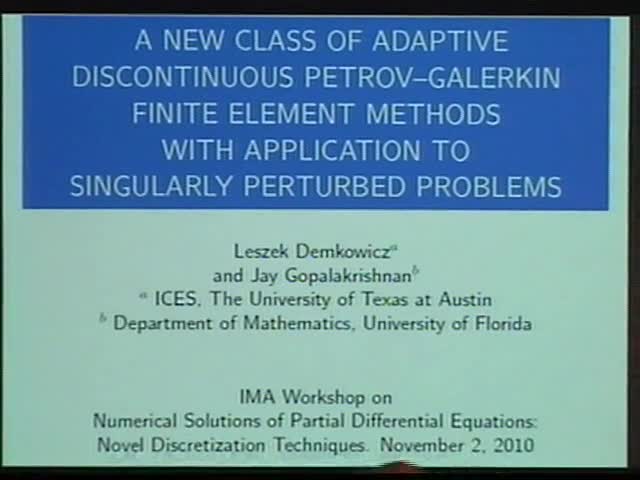A new class of adaptive discontinuous Petrov-Galerkin (DPG) finite element (FE) methods with application to singularly perturbed problems
Presenter
November 2, 2010
Keywords:
- singularly perturbed problems
MSC:
- 65L11
Abstract
Joint work with Jay Golapalakrishnan, U. Florida.
Adaptive finite elements vary element size h or/and
polynomial order p to deliver approximation properties superior
to standard discretization methods. The best approximation
error
may converge even exponentially fast to zero as a function of
problem size (CPU time, memory). The adaptive methods are thus
a natural
candidate for singularly perturbed problems like
convection-dominated
diffusion, compressible gas dynamics, nearly incompressible
materials, elastic deformation of structures with thin-walled
components, etc. Depending upon the problem, diffusion
constant,
Poisson ratio or beam (plate, shell) thickness, define the
small
parameter.
This is the good news. The bad news is that only a small
number
of variational formulations is stable for adaptive meshes
By the stability we mean a situation where the discretization
error can be bounded by the best approximation error times
a constant that is independent of the mesh. To this class
belong
classical elliptic problems (linear and non-linear),
and a large class of wave propagation problems whose
discretization
is based on hp spaces reproducing the classical exact
grad-curl-div
sequence. Examples include acoustics, Maxwell equations,
elastodynamics,
poroelasticity and various coupled and multiphysics problems.
For singularly perturbed problems, the method should also be
robust, i.e. the stability constant should be independent
of the perturbation parameter. This is also the dream for
wave propagation problems in the frequency domain where the
(inverse of) frequency can be identified as the perturbation
parameter. In this context, robustness implies a method
whose stability properties do not deteriorate with the
frequency
(method free of pollution (phase) error).
We will present a new paradigm for constructing
discretization
schemes for virtually arbitrary systems of linear PDE's that
remain stable for arbitrary hp meshes, extending thus
dramatically
the applicability of hp approximations. The DPG methods build
on two fundamental ideas:
- a Petrov-Galerkin method with optimal test functions for
which
continuous stability automatically implies discrete
stability,
- a discontinuous Petrov-Galerkin formulation based on the
so-called ultra-weak variational hybrid formulation.
We will use linear acoustics and convection-dominated
diffusion
as model problems to present the main concepts and then review
a number of other applications for which we have collected some
numerical experience including:
1D and 2D convection-dominated diffusion (boundary layers)
1D Burgers and compressible Navier-Stokes equations
(shocks)
Timoshenko beam and axisymmetric shells (locking, boundary
layers)
2D linear elasticity (mixed formulation, singularities)
1D and 2D wave propagation (pollution error control)
2D convection and 2D compressible Euler equations (contact
discontinuities and shocks)
The presented methodology incorporates the following features:
The problem of interest is formulated as a system of first
order PDE's in the distributional (weak) form, i.e. all
derivatives
are moved to test functions. We use the DG setting, i.e. the
integration by parts is done over individual elements.
As a consequence, the unknowns include not only field
variables within
elements but also fluxes on interelement boundaries. We do not
use the concept of a numerical flux but, instead, treat the
fluxes as
independent, additional unknowns (a hybrid method).
For each trial function corresponding to either field or
flux
variable, we determine a corresponding optimal test function
by solving an auxiliary local problem on one element.
The use of optimal test functions guarantees attaining the
supremum
in the famous inf-sup condition from Babuska-Brezzi theory.
The resulting stiffness matrix is always hermitian and
positive-definite. In fact, the method can be interpreted as a
least-squares
applied to a preconditioned version of the problem.
By selecting right norms for test functions, we can obtain
stability properties uniform not only with respect to
discretization
parameters but also with respect to the perturbation parameter
(diffusion constant, Reynolds number, beam or shell thickness,
wave number)
In other words, the resulting discretization is robust.
For a detailed presentation on the subject, see [1-8].
[1] L. Demkowicz and J. Gopalakrishnan.
A Class of Discontinuous Petrov-Galerkin Methods.
Part I: The Transport Equation.
Comput. Methods Appl. Mech. Engrg., in print.
see also ICES Report 2009-12.
[2] L. Demkowicz and J. Gopalakrishnan.
A Class of Discontinuous Petrov-Galerkin Methods.
Part II: Optimal Test Functions.
Numer. Mth. Partt. D.E., accepted,
ICES Report 2009-16.
[3] L. Demkowicz, J. Gopalakrishnan and A. Niemi.
A Class of Discontinuous Petrov-Galerkin Methods.
Part III: Adaptivity.
ICES Report 2010-1, submitted to ApNumMath.
[4] A. Niemi, J. Bramwell and L. Demkowicz,
"Discontinuous Petrov-Galerkin Method with
Optimal Test Functions for Thin-Body Problems in Solid
Mechanics,"
ICES Report 2010-13, submitted to CMAME.
[5] J. Zitelli, I. Muga, L, Demkowicz, J. Gopalakrishnan, D.
Pardo and
V. Calo,
"A class of discontinuous Petrov-Galerkin methods. IV:
Wave propagation problems,
ICES Report 2010-17, submitted to J.Comp. Phys.
[6] J. Bramwell, L. Demkowicz and W. Qiu,
"Solution of Dual-Mixed Elasticity Equations
Using AFW Element and DPG. A Comparison"
ICES Report 2010-23.
[7] J. Chan, L. Demkowicz, R. Moser and N Roberts,
"A class of Discontinuous Petrov-Galerkin methods.
Part V: Solution of 1D Burgers and Navier--Stokes
Equations"
ICES Report 2010-25.
[8] L Demkowicz and J. Gopalakrishnan, "A Class of
Discontinuous
Petrov-Galerkin Methods. Part VI: Convergence Analysis for
the Poisson
Problem," ICES Report, in preparation.
